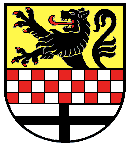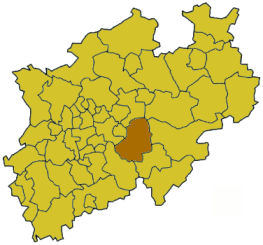|
|
| Statistics | |
|---|---|
| State: | North Rhine-Westphalia |
| Capital: | Lüdenscheid |
| Adm. Region: | Arnsberg |
| Area: | 1,058.949 km² |
| Inhabitants: | 457,465 (2001) |
| pop. density: | 432 inh./km² |
| Car identification: | MK |
| Homepage: | http://www.maerkischer-kreis.de |
| Map | |
The Märkische Kreis is a district (Kreis) in central North Rhine-Westphalia, Germany. Neighbouring districts are Unna, Soest, Hochsauerland, Olpe, Oberbergischer Kreis, Ennepe-Ruhr, and the city of Hagen.
| Contents |
History
The district was created in 1975 as part of the reorganization of North Rhine-Westphalian districts. The former districts of Lüdenscheid and Iserlohn, together with the city of Iserlohn, plus the area around Balve (previously part of Arnsberg District) were amalgamated to form the new district. Lüdenscheid District itself had been created just a few years earlier, in 1968, when the city of Lüdenscheid was merged with Altena District (originally created in 1753). The name Märkische Kreis was chosen in recognition of the fact that part of the territory formerly belonged to the earldom of Mark.
Twinning
Twinning with Wrexham County Borough (Wales, United Kingdom) dates from 1970 and was initiated by the precursor district, Iserlohn.
In 1992 a twinning agreement was reached with the Finsterwalde District of Brandenburg, unofficial relations between the two districts having existed since German reunification in 1990. Following Finsterwald's merger with the district of Elbe-Elster, twinning with the new district was reconfirmed in 1996.
In 2001 a twinning agreement was officially established with the Polish district of Racibórz.
Geography
Geographically speaking, the Märkische Kreis covers the northwestern part of the Sauerland mountains, south of the Ruhr valley. The highest point, at 683 metres above sea level, is the Nordhelle. The district's principal river is the Lenne. Although most of the district is covered by forest and is rather sparsely inhabited, the area has had a long industrial history: it was, in fact, the very abundance of timber in the area which made steel-working possible here long before Ruhr coal became readily available.
Coat of arms

| The lion and chequerboard are taken from the old coat of arms of the district of Altena, which derived from the arms of the earls of Mark. In the first half 13th century a seal with both the bar and the lion was used, first used Adolf I of Altena (1199-1241). Engelbert I of the Mark (1249-1277) dropped the lion in his seal. The original color of the lion isn't known, thus a black lion with red tongue and claws was chosen. The black cross comes from the arms of Cologne, as the eastern part of the area historically belonged to the Bishops of Cologne.
The coat of arms was designed by the heraldic Waldemar Mallek, and was granted on May 6, 1976. |
Towns and municipalities
| Cities | Municipalities | |
|---|---|---|
Politics
The district is led by a Landrat. Originally the Landrat was only a representative post, while the Oberkreisdirektor was the head of the administration, however since 1999 the two posts are unified.
| Landrat | Oberkreisdirektor |
|---|---|
|
|
The last election was on September 26 2004.
| Party | Votes | Seats |
|---|---|---|
| CDU | 44.4% | 32 |
| SPD | 30.0% | 22 |
| Greens | 7.7% | 6 |
| FDP | 7.4% | 5 |
| Independent (UWG) | 6.7% | 5 |
| NPD | 1.9 % | 1 |
| Republican | 1.8 % | 1 |
External links
- Official website (http://www.maerkischer-kreis.de) (German)
- Touristical website for the Märkische Kreis (http://www.mk-tourismus.de) (German)
Template:Germany districts north rhine-westphaliade:Märkischer Kreis fr:Mark (arrondissement) nl:Märkischer Kreis

